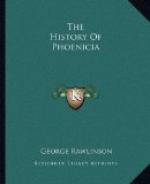Animal and human forms intermixed occur on a silver patera found at Athienau, which is more complicated and elaborate than the objects hitherto described, but which is, like them, strikingly Egyptian.[771] A small rosette occupies the centre; round it is, apparently, a pond or lake, in which fish are disporting themselves; but the fish are intermixed with animal and human forms—a naked female stretches out her arms after a cow; a man clothed in a shenti endeavours to seize a horse. The pond is edged by papyrus plants, which are alternately in blossom and in bud. A zigzag barrier separates this central ornamentation from that of the outer part of the dish. Here a marsh is represented in which are growing papyrus and other water-plants. Aquatic birds swim on the surface or fly through the tall reeds. Four boats form the chief objects in this part of the field. In one, which is fashioned like a bird, there sits under a canopy a grandee, with an attendant in front and a rower or steersman at the stern. Behind him, in a second boat, is a band consisting of three undraped females, one of whom plays a harp and another a tambourine, while the third keeps time with her hands. A man with a punt-pole directs the vessel from the stern. In the third boat, which has a freight of wine-jars, a cook is preparing a bird for the grandee’s supper. The fourth boat contains three rowers, who possibly have the vessel of the grandee in tow. The first and second boats are separated by two prancing steeds, the second and third by two cows, the third and fourth by a chariot and pair. It is difficult to explain the mixture of the aquatic with the terrestrial in this piece; but perhaps the grandee is intended to be enjoying himself in a marshy part of his domain, where he might ride, drive, or boat, according to his pleasure. The whole scene is rather Egyptian than Phoenician or Cypriot, and one cannot help suspecting that the patera was made for an Egyptian customer.
There is a patera at Athens,[772] almost certainly Phoenician, which may well be selected to introduce the more elaborate and complicated of the Phoenician works of art in this class. It has been figured,[773] and carefully described by MM. Perrot and Chipiez in these terms:—“The medallion in the centre is occupied by a rosette with eight points. The zone outside this, in which are distributed the personages represented, is divided into four compartments by four figures, which correspond to each other in pairs. They lift themselves out of a trellis-work, bounded on either side by a light pillar without a base. The capitals which crown the pillars recall those of the Ionic order, but the abacus is much more developed. A winged globe, stretching from pillar to pillar, roofs in this sort of little chapel; each is the shrine of a divinity. One of the divinities is that nude goddess, clasping her breasts with her hands, whom we have already met with in the Phoenician




